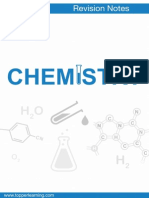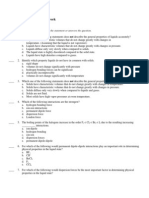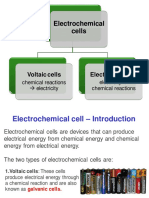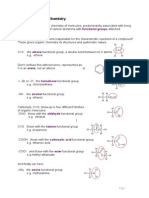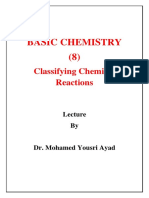F325 Redox Equations and Titrations
F325 Redox Equations and Titrations
Uploaded by
Doc_CrocCopyright:
Available Formats
F325 Redox Equations and Titrations
F325 Redox Equations and Titrations
Uploaded by
Doc_CrocCopyright
Available Formats
Share this document
Did you find this document useful?
Is this content inappropriate?
Copyright:
Available Formats
F325 Redox Equations and Titrations
F325 Redox Equations and Titrations
Uploaded by
Doc_CrocCopyright:
Available Formats
F325 Redox Equations and Titrations
Redox Equations and Titrations
Redox explain, for simple redox reactions, the terms redox, oxidation number, half-reaction, oxidising agent and reducing agent construct redox equations using relevant half equations or oxidation numbers interpret and make predictions for reactions involving electron transfer. Redox reactions and titrations describe, using suitable examples, redox behaviour in transition elements carry out redox titrations, and carry out structured calculations, involving MnO4 and I2/S2O32 perform non-structured titration calculations, based on experimental results.
Terminology Redox reactions are ones in which both reduction and oxidation takes place simultaneously. We recognize this because one reacting species will have an increase in oxidation number (i.e. it will be oxidized, by losing electrons) while another reacting species will show a decrease in oxidation number (i.e. it will be reduced, by gaining electrons). The species which causes the other to be oxidized is called the oxidizing agent (it will itself get reduced during the reaction) and the species which causes the other to be reduced is the reducing agent (and it will itself get oxidized). Consider the rather spectacular reaction between magnesium and copper oxide. When heated together, a violently exothermic displacement takes place: Mg + CuO MgO + Cu We can see what is going on by writing two half equations one for the oxidation and one for the reduction. Note that the oxide ion is a spectator ion, unchanged by the reaction. It therefore does not show up in either half-equation: Oxidation: Reduction: Mg Mg2+ + 2eCu2+ + 2e- Cu
So the magnesium is acting as the reducing agent, and the copper oxide is acting as the oxidizing agent.
p. 1
F325 Redox Equations and Titrations
Constructing redox equations method using half-equations
Example: oxidation of Fe2+ and reduction of MnO4Acidified manganate(VII) ions are a powerful oxidizing agent. They can oxidize Fe 2+ ions to Fe3+ ions. At the same time the manganate(VII) ions are reduced to Mn 2+ ions. We can represent what happens to the iron ions with a half-equation The number of electrons to include comes from the change in oxidation number of the species being oxidized or reduced: Oxidation is loss of electrons: oxidation number of Fe: Fe2+(aq) pale green +2 Fe3+(aq) + eyellow +3
There is a corresponding half equation for the reduction of acidified manganate(VII) ions: Reduction is gain of electrons: oxidation number of Mn: MnO4-(aq) + 8H+(aq) + 5e- Mn2+(aq) purple very pale pink +7 +2 + 4H2O(l)
To write an overall equation for what happens, we need to have the same number of electrons lost in the oxidation as are gained in the reduction, so we need to multiply the first halfequation by 5 throughout: 5 Fe2+(aq) 5 Fe3+(aq) + 5 e-
Then we can simply add the half equations together, and cancel the five electrons on each side: MnO4-(aq) + 8H+(aq) + 5e Mn2+(aq) + 4H2O(l) 5 Fe2+(aq) 5 Fe3+(aq) + 5 eSo Example: MnO4-(aq) + 8H+(aq) + 5Fe2+(aq) 5 Fe3+(aq) reduction of dichromate ions + Mn2+(aq) + 4H2O(l)
We are also familiar with acidified potassium dichromate as a powerful oxidizing agent. The dichromate ions act in a similar way to the manganate(VII) ions. As an example, they can oxidize Sn2+ ions to Sn4+ ions. You should recall that dichromate ions are an intense orange colour, and that when they act as an oxidizing agent, their colour changes to dark green. This is because they have been reduced to Cr3+ ions.
p. 2
F325 Redox Equations and Titrations Again we can represent what happens with half-equations: Sn2+(aq) Sn4+(aq) + 2eCr2O72-(aq) + 14H+(aq) + 6e- 2Cr3+(aq) + 7H2O(l)
Oxidation Reduction
And again we can combine these into a single redox equation by getting the same number of electrons in each half equation i.e. multiplying the oxidation equation by 3 throughout. 3Sn2+(aq) + Cr2O72-(aq) + 14H+(aq) + 6e- 3Sn4+(aq) + 6e- + 2Cr3+(aq) + 7H2O(l) N.B. we can also be asked to work out the oxidation or reduction half equation if we are given the overall equation and the other half-equation: Using the same example as above, we might be told that the overall equation is: 3Sn2+(aq) + Cr2O72-(aq) + 14H+(aq) 3Sn4+(aq) + 2Cr3+(aq) + 7H2O(l) and that the oxidation part is Sn2+ Sn4+ + 2e-. We are required to work out the reduction half-equation: Firstly multiply the given half-equation up to get the same stochiometry (numbers in front of the formulae) as in the overall equation: 3Sn2+ 3Sn4+ + 6eNow compare this to the overall equation and work out what is missing on each side this must be what is in the reduction half-equation: Oxidation Reduction Overall 3Sn2+ Cr2O72 3Sn4+ + 14H+ + 6e- 2Cr3+ + + 6e7H2O
3Sn2+(aq) + Cr2O72-(aq) + 14H+(aq)
3Sn4+(aq) + 2Cr3+(aq) + 7H2O(l)
Constructing redox equations Method using oxidation numbers
We can balance a redox equation by making sure that the increase in oxidation numbers due to the oxidation taking place is balanced by the decrease in oxidation numbers due to the reduction taking place, without having to construct separate half-equations. The key is that the total increase in oxidation numbers in the balanced equation must be equal to the total decrease in oxidation numbers. e.g. hydrogen iodide (HI) is oxidized to iodine by concentrated sulphuric acid. The sulphuric acid is reduced to hydrogen sulphide. Construct a balanced equation for this.
p. 3
F325 Redox Equations and Titrations Step 1: Write an equation using the formulae for reactants and products you know about HI + H2SO4 I2 + H2S - don't worry about balancing or missing atoms yet !
Step 2: Add the oxidation numbers to see what is oxidized and what is reduced HI + +1 -1 H2SO4 +1 +6 -2-2 +1 -2-2 I2 0 + H2S +1 -2 +1
You may want to get rid of those oxidation numbers which don't change, or don't have a 'partner' on both sides of the equation, so you can see the reduction and oxidation clearly HI + -1 H2SO4 +6 I2 0 + H2S -2
Step 3: Balance the equation FOR ONLY THOSE ATOMS BEING OXIDISED OR REDUCED. Don't worry about O or H atoms which are still not balanced, yet. 2HI + H2SO4 I2 + H2S
Step 4: Add the oxidation numbers for each species being oxidized or reduced, too see what the total increase and decrease in oxidation numbers is: 2 HI + -1 -1 -2 H2SO4 +6 I2 0 0 0 + H2S -2
So total reduction (S) is +6 to -2 = -8 Total oxidation (I) is -2 to 0 = +2 Step 4: Balance the increase and decrease in oxidation numbers in this case we need the 2HI I2 to happen four times to balance one H2SO4 H2S 8 HI + H2SO4 4 I2 + H2S
Step 5: Check if anything else needs to be balanced. If we are missing oxygen atoms, add water to that side. Then if we are missing hydrogen atoms, add H + to that side (look for 'acidic conditions' in the question as another clue as to when to include H + as a reactant !) 8HI Finally: + H2SO4 4 I2 + H2S + 4 H 2O
Check it is balanced for all elements Check it is balanced for charge total charge on each side the same.
p. 4
F325 Redox Equations and Titrations Practice: 1) Use oxidation numbers to write balanced equations for the following redox reactions: a) Hydrogen sulphide, H2S is oxidized to sulphur, S, by nitric acid, HNO3, which is itself reduced to nitrogen monoxide, NO. b) In acidic conditions, silver metal, Ag, is oxidized to silver(I) ions, Ag + by NO3- ions, which are reduced to nitrogen monoxide (NO). 2) Prove that oxidation numbers method produces the same result as we previously obtained using the half-equation method for the reaction between manganate(VII) ions and iron(II). Acidified managanate(VII) ions are capable of oxidizing iron(II) ions to iron(III) ions. The manganate is reduced to Mn2+ ions:
Redox titrations
In a redox titration we are titrating one solution in which something is going to be oxidized, against another in which something is going to be reduced. If we know the concentration of one substance, we can work out the concentration of the other from a balanced equation for the redox reaction. We don't use a pH indicator in a redox titration. Changes in colour of the substances being oxidized and reduced tell us when we have reached the equivalence point. There are two examples we should understand fully, although we may meet other examples of redox titrations where information about the titration is provided in the question.
Titration of iron(II) ions using manganate(VII) ions under acidic conditions
Purpose: To determine the concentration of Fe2+(aq) in a solution. e.g. determining the mass of iron in iron tablets determining the %purity of iron in an alloy containing iron determining the concentration of iron(II) ions in contaminated water determining the molar mass and formula of an iron(II) salt How to do it: If the sample to be investigated isn't already a solution containing iron(II) ions, it may need to be crushed and dissolved in water and sulphuric acid. We'll need to measure the mass of the sample before dissolving. The resulting solution will be pale green (almost colourless if the concentration of iron(II) is fairly low). We titrate a known volume of the sample against potassium managate(VII) solution (potassium permanganate) of known concentration. As the deep purple manganate(VII) ions mix with the iron(II) ions they are decolourised. This continues until all the iron(II) ions have reacted. The next drop of potassium manganate(VII) stays purple, so the endpoint is when the first hint of pink/purple persists in the solution. p. 5
F325 Redox Equations and Titrations The chemistry: The managanate(VII) ions (MnO4-) are reduced to managese(II), while the iron(II) is oxidized to iron(III) ions. We have already constructed an equation for this: MnO4-(aq) + 8H+(aq) + 5e- Mn2+(aq) + 4H2O(l) 2+ 3+ 5 Fe (aq) 5 Fe (aq) + 5 eSo MnO4-(aq) + 8H+(aq) + 5Fe2+(aq) 5 Fe3+(aq) + Mn2+(aq) + 4H2O(l) The important consequence of this equation is that one mole of MnO 4- ions reacts with five moles of Fe2+ so we have the mole ratio of 1:5 when we do the titration calculation. Example calculations: 25.0cm3 of a solution of iron(II)sulphate required 23.0cm 3 of 0.0020 mol dm-3 potassium permanganate to completely oxidize it in acidic solution. What was the concentration of the iron(II)sulphate solution ? Step 1: Calculate moles of the permanganate moles = conc. x vol in dm3 = 0.00200 x (23/1000) = 4.60 x 10-5 moles Step 2: Use the mole ratio from the balanced equation to get moles of iron(II) ions MnO4-(aq) + 8H+(aq) + 5Fe2+(aq) 5 Fe3+(aq) + Mn2+(aq) + 4H2O(l) 1 : 5 4.60x10-5 2.30 x 10-4 moles of Fe(II) Step 3: Calculate concentration of iron(II) sulphate solution Conc of Fe(II) = moles / vol (in dm3) = 2.3x10-4 / 0.0025 = 0.00920 mol dm-3 The solution above was made by dissolving a tablet containing hydrated iron(II) sulphate and sucrose (which does not react with permanganate ions) in 250cm 3 of water. Calculate the mass of FeSO4 in the tablet. Step 1: Convert concentration of iron(II) solution into moles 0.00920 mol dm-3 of iron sulphate = 0.00920 * (250 / 1000) = 0.0023 moles FeSO 4 were 3 dissolved in the 250cm of water, so 0.0023 moles of iron(II) sulphate were in the tablet. Step 2: Calculate mass of FeSO4 dissolved: Mass of FeSO4= 0.0023 x RFM = 0.0023 x (55.8 + 32.1 + (16.0 x 4)) = 0.0023 x 151.9 = 0.350g The formula for the hydrated iron sulphate used in the tablet is FeSO 4.7H2O. If the mass of the tablet was 8.5g, calculate the % by mass of hydrated iron II sulphate in the tablet. RFM of FeSO4.7H2O = 151.9 + (7 x 18) = 277.9 Mass in tablet = moles x RFM = 0.023 x 277.9 % by mass = (0.6392 / 8.5) x 100 = 7.5 % = 0.6392g
p. 6
F325 Redox Equations and Titrations
Titration of iodine in solution using thiosuphate ions
Purpose: To determine the concentration of an oxidizing agent in a solution e.g. Cu 2+(aq) ions. e.g. determining the % of copper in an alloys such as brass or bronze determining concentration of copper ions in a solution determining concentration of dichromate ions in a solution determining the concentration of chlorate(I) ions ClO - in bleach determining the concentration of a hydrogen peroxide solution How to do it: The analysis is done in two stages. In the first stage, the oxidizing agent to be determined is reacted with excess iodide ions. This results in iodine being formed in the solution, the amount of iodine being directly related to the amount of the oxidizing agent present. e.g. 2Cu2+(aq) + 4I-(aq) 2CuI(s) + I2(aq) so in this case 2 moles of Cu2+ ions produce 1 mole of iodine. In the second stage, the concentration of iodine in the solution is determined by titrating it against sodium thiosulphate of known concentration. The red-brown colour of the iodine in solution fades to a pale straw colour, and to colourless when all the iodine has been reduced to iodide ions. This makes the endpoint difficult to see, so close to the endpoint an amount of starch is added as an indicator. Starch is blue-black when iodine is present, but at the endpoint the starch becomes colourless. The chemistry: I2(aq) + 2e- 2I-(aq) reduction
At the same time the thiosulphate ions are oxidized to tetrathionate ions: 2 S2O32-(aq) S4O62-(aq) + 2eThe overall equation is therefore: I2(aq) + 2 S2O32-(aq) 2I-(aq) + S4O62-(aq) This means that 2 moles of thiosulphate ions react with 1 mole of iodine. Example calculations The calculation is also done in two stages. In the first stage, the titre for the thioulphate is used along with its concentration and the mole ratio above to work out the number of moles of iodine in the portion of solution which was titrated. In the second stage, the moles of iodine in the whole solution are used along with the mole ratio of iodine to oxidizing agent to work out the concentration of oxidizing agent added originally present in the whole solution. This can then be used further if needed to work out the mass of the oxidizing agent given a formula etc. oxidation
p. 7
F325 Redox Equations and Titrations
e.g. 30cm3 of bleach was reacted completely with iodide ions in acidic solution. The iodine formed was titrated against 0.200 mol dm-3 sodium thiosulphate, requiring 29.45cm3 of the thiosulphate solution to reach the endpoint. The chlorate(I) ions in the bleach react with iodide ions according to the equation: ClO-(aq) + 2I-(aq) + 2H+(aq) Cl-(aq) + I2(aq) + H2O(l) Calculate the concentration of the chlorate ions in the bleach. Firstly use the titration data to get the moles of iodine which was released when the bleach reacted with the excess iodide ions. Step 1: Calculate moles of thiosulphate ions used moles = conc x vol (in dm3) = 0.200 x (29.45/1000) = 5.89 x 10-3 moles Step 2: Use the balanced equation for the titration to get moles of iodine I2(aq) + 2 S2O32-(aq) 2I-(aq) + S4O62-(aq) 1 : 2 2.945 x 10-3 : 5.89x10-3 Secondly use the moles of iodine to find moles of chlorate ions, using the first equation ClO-(aq) + 2I-(aq) + 2H+(aq) Cl-(aq) + I2(aq) + H2O(l) 1 : 2 : 1 2.945 x 10-3 2.945 x 10-3 Step 3: Calculate concentration of chlorate ions: conc of chlorate(I) = moles / vol (in dm3) = 2.945 x 10-3 / 0.030 = 0.0982 mol dm-3
p. 8
F325 Redox Equations and Titrations Answers to Practice Questions 1a) Hydrogen sulphide, H2S is oxidized to sulphur, S, by nitric acid, HNO 3, which is itself reduced to nitrogen monoxide, NO. Step 1 Step 2 Step 3 Step 4 Step 5 H2S -2 + HNO3 +5 S 0 + NO +2
no further balancing needed
oxidation (S) -2 to 0 = +2 reduction (N) +5 to +2 = -3
need 3x (H2SS) and 2x (HNO3 NO) to balance 3H2S + 2HNO3 3S +
2NO
missing 4 x O on RHS so add 4x H2O (then no need to add H+) 3H2S + 2HNO3 3S + 2NO + 4H2O
1b) In acidic conditions, silver metal, Ag, is oxidized to silver(I) ions, Ag + by NO3- ions, which are reduced to nitrogen monoxide (NO). Step 1 Step 2 Step 3 Step 4 Step 5 Ag 0 + NO3- + +5 H+ Ag+ +1 + NO +2
no further balancing needed Need x3 (Ag+ Ag) 3Ag + NO3- +
oxidation (Ag) 0 to +1 = +1 reduction (N) +5 to +2 = -3 3 Ag+ +
H+
NO
Need 2 more O on RHS, so add 2H2O. Balancing then needs 4H+ on LHS. 3Ag + NO3- + 4H+ 3Ag+ + NO + 2H2O
2) Acidified managanate(VII) ions are capable of oxidizing iron(II) ions to iron(III) ions. The manganate is reduced to Mn2+ ions: Step 1 Step 2 Step 3 Step 4 MnO4- + +7 Fe2+ +2 +H+ Mn2+ + +2 Fe3+ +3
no further balancing Need 5x (Fe2+ Fe3+) MnO4- + 5 Fe2+
oxidation +2 to +3 = +1 +H+
reduction +7 to +2 = -5 5 Fe3+
Mn2+ +
Step 5
Need four O on RHS, so add 4H2O. Balancing then requires 8H+ on LHS MnO4- + 5 Fe2+ +8 H+ Mn2+ + 5 Fe3+ + 4H2O p. 9
You might also like
- A2 MatsDocument18 pagesA2 MatsHubert SelormeyNo ratings yet
- Experiment 4: Effect of Concentration and Temperature On Rate of Reaction (Dissappearing Cross)Document24 pagesExperiment 4: Effect of Concentration and Temperature On Rate of Reaction (Dissappearing Cross)Malini RajeshNo ratings yet
- University of Baharain Department of Chemistry General Chemistry 101Document14 pagesUniversity of Baharain Department of Chemistry General Chemistry 101Ahmed AwadNo ratings yet
- Answer Scheme Practice CORONA - 1-1Document12 pagesAnswer Scheme Practice CORONA - 1-1Mumtaz Barhiya100% (1)
- Solubility Rules: Name - Chem Worksheet 15-1Document1 pageSolubility Rules: Name - Chem Worksheet 15-1Mohamed El-sherbinyNo ratings yet
- AP Chemistry - Acid-Base Titration LabDocument3 pagesAP Chemistry - Acid-Base Titration LabJonathan Chen0% (1)
- Determination of Ka of Unknown AcidDocument23 pagesDetermination of Ka of Unknown AcidShasha0% (1)
- Hem Actsheet: Redox Equilibria IV - Redox TitrationsDocument3 pagesHem Actsheet: Redox Equilibria IV - Redox TitrationsAya ZhNo ratings yet
- CHM12 Experiment 5 KineticsDocument15 pagesCHM12 Experiment 5 Kineticsshaam030% (2)
- Practice Makes Perfect in Chemistry: Oxidation-ReductionFrom EverandPractice Makes Perfect in Chemistry: Oxidation-ReductionRating: 5 out of 5 stars5/5 (1)
- Practice Makes Perfect in Chemistry: Acids, Bases, and Salts with AnswersFrom EverandPractice Makes Perfect in Chemistry: Acids, Bases, and Salts with AnswersNo ratings yet
- F325 Acids and PHDocument19 pagesF325 Acids and PHDoc_CrocNo ratings yet
- To Study The Kinetics of Persulphate-Iodide Ion Reaction by Initial Rate Method (Iodine Clock Reaction)Document12 pagesTo Study The Kinetics of Persulphate-Iodide Ion Reaction by Initial Rate Method (Iodine Clock Reaction)Nishika GeraNo ratings yet
- Electrochemistry - Voltaic Cells (A Lab)Document14 pagesElectrochemistry - Voltaic Cells (A Lab)John To50% (2)
- Precipitation ReactionsDocument3 pagesPrecipitation ReactionsborgiamatriceNo ratings yet
- Test BanksDocument21 pagesTest Banksalex_flutistNo ratings yet
- Chemical Kinetics Part - IDocument43 pagesChemical Kinetics Part - ISanskar BhattacharyaNo ratings yet
- 7 - JEE - Chemistry - Electrochemistry - Transport Number or Transference NumberDocument2 pages7 - JEE - Chemistry - Electrochemistry - Transport Number or Transference NumberGurmehakdeep Billa100% (1)
- Solubility Notes Unit 3Document17 pagesSolubility Notes Unit 3cutecatmaryamNo ratings yet
- D&F NotesDocument49 pagesD&F Notesmariamiqbal0929No ratings yet
- Chapter 01 Properties of SolutionDocument70 pagesChapter 01 Properties of SolutionSharveen Gopal100% (1)
- Problems ElectrochemistryDocument11 pagesProblems ElectrochemistryorlandompsilvaNo ratings yet
- Revision Notes For Class 12 CBSE Chemistry, Amines - TopperlearningDocument11 pagesRevision Notes For Class 12 CBSE Chemistry, Amines - TopperlearningRishabh BhandariNo ratings yet
- Solubilitynotesnocomicsv4 PDFDocument29 pagesSolubilitynotesnocomicsv4 PDFterryNo ratings yet
- CMT552 4 Electrolyte ConductanceDocument57 pagesCMT552 4 Electrolyte ConductanceAira Ariana100% (1)
- Chapter: 1 Stoichiometric Relationships: SubtopicsDocument108 pagesChapter: 1 Stoichiometric Relationships: SubtopicsBNo ratings yet
- Acid Base Titration (Theory) - Inorganic Chemistry Virtual Lab - Chemical Sciences - Amrita Vishwa Vidyapeetham Virtual LabDocument8 pagesAcid Base Titration (Theory) - Inorganic Chemistry Virtual Lab - Chemical Sciences - Amrita Vishwa Vidyapeetham Virtual Labpankaj111No ratings yet
- Grade 12: CAPE Chemistry Module 1 RedoxDocument18 pagesGrade 12: CAPE Chemistry Module 1 RedoxEmily ZhengNo ratings yet
- Titration Chemistry Lab Report Vitamin CDocument4 pagesTitration Chemistry Lab Report Vitamin CAlias AliquidNo ratings yet
- Hayes - Lanthanides & ActinidesDocument113 pagesHayes - Lanthanides & Actinidesnikparis67% (3)
- Acid Base - NeutralizationDocument71 pagesAcid Base - NeutralizationAyen AyieNo ratings yet
- Chemical Equilibrium NotesDocument11 pagesChemical Equilibrium NotesNeha Kaur SinhaNo ratings yet
- Unit-1 MCQDocument6 pagesUnit-1 MCQAnupa MedhekarNo ratings yet
- D and F - Block Elements in NutshellDocument14 pagesD and F - Block Elements in NutshellPrem Mehrotra100% (1)
- Bronsted Lewry TheoriesDocument27 pagesBronsted Lewry TheoriesSagita AfifNo ratings yet
- 18.0 Carbonyl CompoundsDocument9 pages18.0 Carbonyl CompoundsKudzayi Tusaumwe100% (2)
- Topic 1 Stoichiometric RelationshipsDocument22 pagesTopic 1 Stoichiometric Relationshipsapi-546066323No ratings yet
- Types of ElectrolytesDocument95 pagesTypes of ElectrolytesDeepak Sirone100% (4)
- 1.1 Introduction To The Particulate Nature of Matter and Chemical ChangeDocument19 pages1.1 Introduction To The Particulate Nature of Matter and Chemical ChangeJuan Fernando Velasco ForeroNo ratings yet
- CH 7 - Isomer TypesDocument4 pagesCH 7 - Isomer Typesharshm_39No ratings yet
- AP Chapter 13 MC Practice Questions With MC AnswersDocument9 pagesAP Chapter 13 MC Practice Questions With MC AnswersapantollanoNo ratings yet
- Unit 4 Chemistry A2 NotesDocument37 pagesUnit 4 Chemistry A2 NotesminayokiNo ratings yet
- Balancing Redox ReactionsDocument9 pagesBalancing Redox ReactionsMohamedou ThiamNo ratings yet
- Van Der Waals ForcesDocument2 pagesVan Der Waals ForcesManP13100% (1)
- AC 101 Unit 1 Titrimetric AnalysisDocument90 pagesAC 101 Unit 1 Titrimetric AnalysisRishabh Kumar Singh100% (1)
- D AND F BLOCK ELEMENT NotesDocument5 pagesD AND F BLOCK ELEMENT NotesM Aro100% (1)
- 10hl.20.1 Types of Organic ReactionsDocument74 pages10hl.20.1 Types of Organic ReactionsKatarina VleugelsNo ratings yet
- Electrochemical Conductivity PDFDocument18 pagesElectrochemical Conductivity PDFwatum ambrose100% (1)
- Lesson 1 Thermochemistry-Exothermic and EndothermicDocument28 pagesLesson 1 Thermochemistry-Exothermic and EndothermicNadine TariganNo ratings yet
- Iodine Clock ReactionDocument6 pagesIodine Clock Reactionilias19730% (1)
- Precipitation Reactions and Gravimetric Analysis PDFDocument30 pagesPrecipitation Reactions and Gravimetric Analysis PDFBarronAliShapiNo ratings yet
- Model Answer Key For Grade 11Document5 pagesModel Answer Key For Grade 11Rohit Sur100% (1)
- Mid Term3 Review 15Document32 pagesMid Term3 Review 15Jeremy SchneiderNo ratings yet
- Solubility, Solubility Product, Precipitation Titration, GravimetryDocument10 pagesSolubility, Solubility Product, Precipitation Titration, GravimetrySURESH100% (3)
- Chemistry Urt ExamDocument9 pagesChemistry Urt ExamAmira AbdallahNo ratings yet
- Lecture 12 - Octahedral Substitution Reactions: 2P32 - Principles of Inorganic Chemistry Dr. M. PilkingtonDocument13 pagesLecture 12 - Octahedral Substitution Reactions: 2P32 - Principles of Inorganic Chemistry Dr. M. PilkingtonAlexa AlexiuNo ratings yet
- Electrochemical Cell SLDocument27 pagesElectrochemical Cell SLRyan BoukaaNo ratings yet
- Applications of Redox ReactionsDocument50 pagesApplications of Redox ReactionsMlamuli MlarhNo ratings yet
- Stoichiometry: Calculations With Chemical Formulas and EquationsDocument53 pagesStoichiometry: Calculations With Chemical Formulas and EquationsMarvin Darius LagascaNo ratings yet
- Applications of Kohlrausch LawDocument6 pagesApplications of Kohlrausch LawNadherdaman Alshamary100% (4)
- HaloalkanesDocument6 pagesHaloalkanesDoc_CrocNo ratings yet
- Formulae and Oxidation NumbersDocument14 pagesFormulae and Oxidation NumbersDoc_CrocNo ratings yet
- Qualitative AnalysisDocument3 pagesQualitative AnalysisDoc_CrocNo ratings yet
- Organic BasicsDocument10 pagesOrganic BasicsDoc_CrocNo ratings yet
- Acid Bases Salts and Reacting QuantitiesDocument11 pagesAcid Bases Salts and Reacting QuantitiesDoc_CrocNo ratings yet
- Rates of ReactionDocument7 pagesRates of ReactionDoc_CrocNo ratings yet
- Acid Bases Salts and Reacting QuantitiesDocument11 pagesAcid Bases Salts and Reacting QuantitiesDoc_CrocNo ratings yet
- AlkenesDocument12 pagesAlkenesDoc_CrocNo ratings yet
- The HalogensDocument5 pagesThe HalogensDoc_Croc100% (1)
- Formulae and Oxidation NumbersDocument14 pagesFormulae and Oxidation NumbersDoc_CrocNo ratings yet
- Structure and ShapesDocument10 pagesStructure and ShapesDoc_CrocNo ratings yet
- Atomic Structure Isotopes and MolesDocument11 pagesAtomic Structure Isotopes and MolesDoc_CrocNo ratings yet
- Enthalpy ChangesDocument17 pagesEnthalpy ChangesDoc_Croc100% (1)
- F325 Lattice EnthalpyDocument12 pagesF325 Lattice EnthalpyDoc_Croc100% (1)
- Forces Between Atoms and MoleculesDocument13 pagesForces Between Atoms and MoleculesDoc_CrocNo ratings yet
- Case Studies in Bonding and StructureDocument3 pagesCase Studies in Bonding and StructureDoc_CrocNo ratings yet
- F325 Transition ElementsDocument18 pagesF325 Transition ElementsDoc_CrocNo ratings yet
- F325 Acids and PHDocument19 pagesF325 Acids and PHDoc_CrocNo ratings yet
- F324 Condensation PolymersDocument7 pagesF324 Condensation PolymersDoc_CrocNo ratings yet
- F324 NMR SpectrosDocument9 pagesF324 NMR SpectrosDoc_CrocNo ratings yet
- F324 AminesDocument4 pagesF324 AminesDoc_CrocNo ratings yet
- Group 1 - Thermodynamics and Kinetics of CorrosionDocument76 pagesGroup 1 - Thermodynamics and Kinetics of CorrosionAlyssa CariazoNo ratings yet
- A03. Mcat Uhs Past Paper 2010 - PinkDocument18 pagesA03. Mcat Uhs Past Paper 2010 - PinkMoonNo ratings yet
- IB DP Chemistry Syllabus Map Old Vs NewDocument7 pagesIB DP Chemistry Syllabus Map Old Vs Newnada.radwan01No ratings yet
- IDB 3047 Student Industrial Project (Sip) Title: Wire Bonding Process OptimizationDocument53 pagesIDB 3047 Student Industrial Project (Sip) Title: Wire Bonding Process Optimizationdennis dancunNo ratings yet
- NCERT Solutions For Class 10 Science Chapter 3 EmbibeDocument7 pagesNCERT Solutions For Class 10 Science Chapter 3 EmbibeIbrahim CheyoNo ratings yet
- 6.3.1 Oxidation & Reduction - CIE IGCSE Chemistry Revision Notes 2023 - Save My ExamsDocument8 pages6.3.1 Oxidation & Reduction - CIE IGCSE Chemistry Revision Notes 2023 - Save My Examshopafe6288No ratings yet
- Chemical Engineering Journal: Dongwon Ki, Sudeep C. Popat, César I. TorresDocument8 pagesChemical Engineering Journal: Dongwon Ki, Sudeep C. Popat, César I. TorresGary Kiel Palacios EspinozaNo ratings yet
- D and F Imp QsDocument5 pagesD and F Imp QsNiyatiNo ratings yet
- NegOr Q1 GenBio1 SLKWeek8 v2Document20 pagesNegOr Q1 GenBio1 SLKWeek8 v2moskovbringerNo ratings yet
- Namma Kalvi 12th Chemistry Unit 9 PPT Material EM 219459Document100 pagesNamma Kalvi 12th Chemistry Unit 9 PPT Material EM 219459RAMESH GNo ratings yet
- How CPRS WorksDocument19 pagesHow CPRS WorksAnonymous i3xDz4TNo ratings yet
- CellsDocument3 pagesCellsBay Nald LaraNo ratings yet
- Oxidation, Reduction and Redox Equations QPDocument5 pagesOxidation, Reduction and Redox Equations QPChioma UchegbuNo ratings yet
- 2.3 SEP - Cell E.M.F. (S) EditDocument42 pages2.3 SEP - Cell E.M.F. (S) EditGuru temp id-03 for KPM-Guru-TempNo ratings yet
- Test 34 - Redox Reactions - Middle of PyramidDocument6 pagesTest 34 - Redox Reactions - Middle of PyramidJay PatelNo ratings yet
- Fe Analysis by REDOX Titration PDFDocument4 pagesFe Analysis by REDOX Titration PDFarun231187No ratings yet
- BASIC ChemistryDocument13 pagesBASIC ChemistryNurharis MunandarNo ratings yet
- Functional Group ChemistryDocument176 pagesFunctional Group ChemistryShriram Nandagopal100% (1)
- Remodeling in Microbial Fuel Cell (MFC) Design and Parameters For The Sustained Production of ElectricityDocument14 pagesRemodeling in Microbial Fuel Cell (MFC) Design and Parameters For The Sustained Production of ElectricityMamta AgarwalNo ratings yet
- Hydrogen Notes Class 11 PDFDocument11 pagesHydrogen Notes Class 11 PDFRakesh Agarwal0% (1)
- Xu 2000Document14 pagesXu 2000Chandra Bhal SinghNo ratings yet
- TT 16 84Document215 pagesTT 16 84GracianoNo ratings yet
- STEM GeneralChem2 Q4 Mod7 W8 Cell PotentialDocument30 pagesSTEM GeneralChem2 Q4 Mod7 W8 Cell PotentialaianaNo ratings yet
- 9701 w13 QP 1Document44 pages9701 w13 QP 1Robert EdwardsNo ratings yet
- Chemical Formulae, Equations, Calculations 1 MSDocument11 pagesChemical Formulae, Equations, Calculations 1 MSMifzal SalihinNo ratings yet
- Oxidation and Reduction-1 (13Document1 pageOxidation and Reduction-1 (13Aditya ChudasamaNo ratings yet
- 6 Soil ChemistryDocument13 pages6 Soil ChemistryRachelle Atienza0% (1)

























